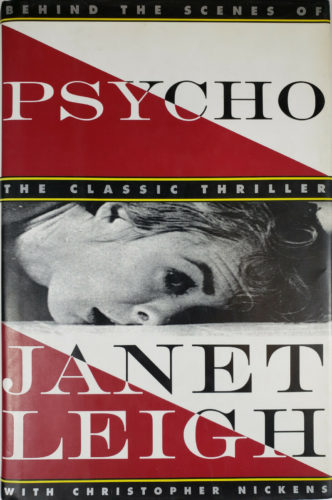 By JANET LEIGH, CHRISTOPHER NICKENS (Harmony Books; 1995)
By JANET LEIGH, CHRISTOPHER NICKENS (Harmony Books; 1995)
This is by no means the first book about the making of Alfred Hitchcock’s PSYCHO (I know of at least one other: Stephen Rebello’s ALFRED HITCHCOCK AND THE MAKING OF PSYCHO), but it is very likely the most definitive. It was written (mostly) by Janet Leigh, the co-star of the film, whose stated purpose was to clear up many of the misconceptions surrounding this legendary production. Most everyone else connected with PSYCHO, after all, is dead, including Hitchcock, novelist Robert Bloch and star Anthony Perkins.
I’ll confess I’ve never been all that bowled over by PSYCHO. It’s an impressive piece of work, certainly, and its impact on a generation of filmgoers–and the movie industry as a whole—cannot be denied or underestimated. But the film has always seemed cold and mechanical to these eyes, and the celebrated shower murder never affected me much. Janet Leigh’s daughter Jamie Lee Curtis apparently found the scene “not jarring or shocking at all,” and I’ll have to agree (it’s always seemed strange to me that the knife never once makes contact with its supposed victim, or leaves any wounds).
Audiences in 1960, however, felt differently. PSYCHO became one of the most financially successful films of all time and irrevocably changed movie exhibition forever. Before it was commonplace for audiences to wander in and out of movies whenever they felt like it, but with PSYCHO Hitchcock ruled that theaters had to be cleared out at the end of each showing—which is how it’s been ever since.
The film also had a tremendous impact on the careers of its director and stars, most notably Anthony Perkins. While offering an enormous amount of praise for the film and its creators, Janet Leigh laments the fact that Perkins was typecast in cookie-cutter psycho roles for much of the remainder of his career.
Beyond that, though, Miss Leigh proves a warm and engaging guide through the world of PSYCHO. She has nothing but good things to say about Alfred Hitchcock (Leigh was among the few blonde starlets he didn’t proposition) and Anthony Perkins (whose homosexuality goes unmentioned). And while she didn’t spend all that much time on the set—her character, remember, was killed off a third of the way through—Leigh was around enough to clear up quite a few long-standing rumors. For the record: no, she wasn’t doused with cold water for the shower murder; no, she didn’t demand specially-made lingerie for the hotel room opening; and no, title designer Saul Bass did not secretly direct the shower sequence!
Included are extensive interviews with the film’s screenwriter Joe Stefano and Perkins’ son Osgood about PSYCHO’S continuing effect on their lives. Co-writer Christopher Nickens periodically breaks in with his own insights on the PSYCHO saga, including extensive background info on the Bloch novel and the development of the screenplay.
The end result is a fast, satisfying read. It will naturally be best appreciated by PSYCHO fanatics, or maybe by those who (like me) are simply curious about why PSYCHO continues to endure. In answering that quarry I’d say this book does about as good a job as any.
